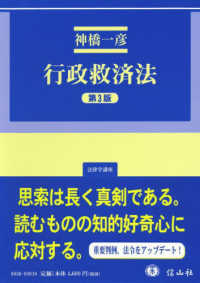- ホーム
- > 洋書
- > ドイツ書
- > Mathematics, Sciences & Technology
- > Biology
- > zoology
Full Description
Invasive species, generally, affect economically important crops, thus affecting the livelihoods of millions of people along crop value chains. Typically, invasive species have high migratory capabilities and, because of plant material exchanges made during trade, they cannot be contained by one country. Usually, African countries react after a pest has invaded and established itself in the country, making the cost of mitigating the pest even more expensive. This book presents a pan-African view of the impacts of invasive insect pests on agriculture and of how invasive species impact on productivity in Africa. It not only describes their importance, but also presents a diversity of research findings in the field, ranging from the use of early warning and monitoring systems for quarantine purposes, agricultural extension, all the way to control strategies. The IPM arsenal presented in this book includes the use of botanical bioactive compounds, semiochemicals, resistant varieties, biological control agents such as entomopathogens, endophytes, predators, and natural enemies. Aspects of technology transfer strategies, regional coordination, and farmers' perceptions have not been overlooked, because these affect the adoption of mitigation strategies. The book also presents measures that would help agricultural research services to estimate the damage and take actions for preparedness and readiness to face invasive insect pests. This starts with a basic knowledge of taxonomy to enable concerned persons to describe the insects and the vast inventory of affected crops. Physiological and ecological aspects of invasive pests are strongly highlighted to strengthen Integrated Pest Management Strategies.
The threat of invasive species will remain permanent; therefore, the book encourages knowledge exchange and collaboration between researchers and scientists on the continent, while encouraging the establishment of a platform or a fund for preparedness and rapid response.
Contents
1. Agriculture and Impact of Invasive Species to Productivity in Africa.- 2. Bioassay-Guided Isolation of Active Phytochemicals Against Tuta Absoluta (Meyrick) from Turraea Floribunda and Caesalpinia Welwitschiana.- 3. Tuta Absoluta (Meyrick): Seasonal Abundance and Susceptibility of some Tomato Genotypes in Gezira State, Sudan.- 4. Evaluation of Resistance and Toxicity of different Insecticides on Tuta absoluta Meyrick Populations in Major Tomato Growing States of Nigeria .- 5. The First Effort at Adopting Integrated Pest Management IPM to Contain the Infestation of the Tuta Absoluta in Nigeria .- 6. New Record of Tuta Absoluta on Cowpea Vigna Unguiculata, Gezira State, Sudan.- 7. Efficacy of a Sudanese Strain of Entomopathogenic Fungus, Metarhizium Anisopliae Met. Sorokin on Puparia of Bactrocera Dorsalis Hendel, under Laboratory Conditions.- 8. Taxonomic keys to Economic Fruit Flies (Diptera: Tephritidae) of the Sudan.- 9. Injury and Yield Losses due to the Maize Stem Borer Busseola Fusca (Fuller) (Lepidoptera: Noctuidae) on Smallholder farms. .- 10. Establishment of an Exotic Parasitoid Cotesia vestalis in Coastal Areas of Kenya as Biological Control Agent of Plutella Xylostella.- 11. Enhancing Monitoring Efficiency and Management of Vectors of Maize Lethal Necrosis Disease in Kenya.- 12. Outbreak of fall Armyworm (Spodoptera Frugiperda) and its Impact in Rwanda Agriculture Production.- 13. Farmers' Perceptions and Preferences on Pesticide use in the Management of Fall armyworm in Rwanda.- 14. Chronological Review of Fruit Fly Research and Management Practices in Sudan.- 15. Integrated Pest Management for Control the Date Palm Green Pit Scale Insect Palmapsis Phoenicis Ra (Homoptera: Asterolecaniidae) in Sudan.- 16. Use of Para-Pheromone Methyl Eugenol for Suppression of the Mango Fruit Fly, Bactrocera Dorsalis (Hendel) (Diptera:Tephritidae) in Southern Ethiopia.- 17. Sudan Thematic Implementation Plan for the Management of Invasive Red Palm Weevil (RPW), Rhynchophorus Ferrugineus (Olivier) .- 18. Management of Pests of Quarantine Importance in Ghana's Export Vegetables (Chili, Eggplant and Ridged Gourds) .- 19. The Role of Plantwise in Improving Detection and Action on Pest Situations .- 20. Semiochemical-Baited Autodissemination Device for Managing BFT on Cowpea .- 21. Influence of Predatory Mites, Phytoseiulus Longipes Evans. on the Within-Plant Diurnal Migration and Distribution of the Red Spider Mite, Tetranychus Evansi, Baker and Pritchard on African Nightshade, Solanum Scabrum.- 22. Effects and Persistence of Endophytic Beauveria Bassiana in Tomato Varieties on Mite Density Tetranychus Evansi in the Screenhouse.- 23. Flight Behaviour and Activity Time of Tuta absoluta (Meyrick) Males Trapped on Tomato and Miscellaneous Crops, Gezira State, Sudan.








